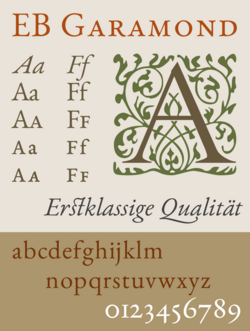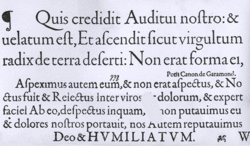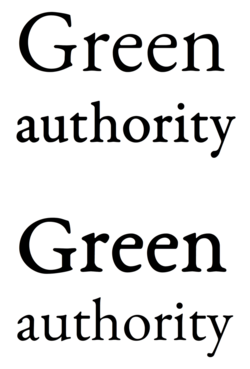EB Garamond
 | |
| Category | Serif |
|---|---|
| Classification | Old-style |
| Designer(s) | Claude Garamont, Robert Granjon, Georg Mayr-Duffner, Octavio Pardo and others |
| Date released | 2011 |
| Glyphs | 3,218 |
| License | OFL |
| Website | Download from Octavio Pardo’s repository Georg Mayr-Duffner about EB Garamond |
| Latest release date | 29 October 2017 |

EB Garamond is a free and open source implementation of Claude Garamond’s typeface, Garamond, and the matching Italic, Greek and Cyrillic characters designed by Robert Granjon. Its name is shortening of Egenolff–Berner Garamond which refers to the fact that the letter forms are taken from the Egenolff–Berner specimen printed in 1592.
Implementation history
In 2011 the Austrian designer Georg Mayr-Duffner[2] released the EB Garamond under the Open Font License. Mayr-Duffner took the letterforms from a scan of a specimen known as the “Berner specimen” which was printed in 1592 by Conrad Berner, son-in-law of Christian Egenolff and his successor at the Egenolff print office. It shows Garamont's roman and Granjon's italic fonts at different sizes. The Greek characters are based on Robert Granjon's work as well. In addition the font includes OpenType features such as swash italic capitals and schoolbook alternates.[3] Duffner's intention was to include multiple optical sizes. As of 2014 his implementation included fonts based on the 8 and 12 point forms from the 1592 specimen, but lacked the bold font faces. As Georg Mayr-Duffner couldn't complete the bold weights for personal reasons, Google commissioned the Spanish type designer Octavio Pardo[4] to continue the project. As of 2018 Pardo's implementation includes 5 weights (Regular, Medium, Semi-Bold, Bold and Extra-Bold), both in regular and italic style.
Technical details
Mayr-Duffner implemented the EB Garamond originally in FontForge using the SFDIR and UFO format. Octavio Pardo switched to the proprietary font editor Glyphs that supports multiple master fonts. Pardo's implementation is hence based on two masters, Regular and Bold. The other weights are generated from the masters. The letter forms and the kerning of Pardo's Regular are identical with Mayr-Duffner's EB Garamond 12. The source of the fonts is drawn with cubic Bézier curves, thus the OTF-version (CFF-style) version of the compiled fonts should be preferred over the TTF-version, as TTF requires quadratic Bézier curves which have to be generated by lossy conversion during the compilation from the source files.
EBGaramond-Maths
EBGaramond-Maths is a package for LaTeX that provides a version of the EB Garamond 12 for mathematics. Its maintainer is Clea F. Rees.[5]
Garamond-Math
Garamond-Math is an additional OpenType font file for the EB Garamond family containing symbols for mathematics. The file is provided by Yuansheng Zhao.[6]
OpenType features
As of 2018, EB Garamond includes the following OpenType features:
| aalt | Access All Alternates | lnum | Lining Figures | ss02 | Stylistic Set 2 |
| c2pc | Petite Capitals From Capitals | mark | Mark Positioning | ss03 | Stylistic Set 3 |
| c2sc | Small Capitals From Capitals | mkmk | Mark to Mark Positioning | ss04 | Stylistic Set 4 |
| case | Case-Sensitive Forms | onum | Oldstyle Figures | ss05 | Stylistic Set 5 |
| dlig | Discretionary Ligatures | ordn | Ordinals | ss06 | Stylistic Set 6 |
| frac | Fractions | pcap | Petite Capitals | ss07 | Stylistic Set 7 |
| hist | Historical Forms | pnum | Proportional Figures | subs | Subscript |
| hlig | Historical Ligatures | sinf | Scientific Inferiors | sups | Superscript |
| kern | Kerning | smcp | Small Capitals | swsh | Swash |
| liga | Standard Ligatures | ss01 | Stylistic Set 1 | tnum | Tabular Figures |
The feature list and additional information can be obtained by tools like otfinfo (e.g. otfinfo -f `kpsewhich EBGaramond-Regular.otf`) or FontDrop!.
Economy
A comparison of different fonts found that Garamond (not EB Garamond specifically) was significantly more economical of toner or ink than most others, including some designed specifically for economy, though Garamond also sets smaller at the same nominal point size.[7]
Reception
The prominent typeface designer Erik Spiekermann described the EB Garamond as "one of the best open source fonts".[8]
Availability
Web
- Georg Mayr-Duffner's implementation lacking the bold faces is available from his GitHub repository.[9] It is still possible to generate font files from that repository using OpenBSD or Linux.[10]
- Octavio Pardo's newer version can be downloaded as OTF and TTF files from his repository.[11]
- Pardo's version is also available for embedding through Google Fonts[12] and through Adobe Fonts.[13]
LaTeX
As Classic LaTeX font
EB Garamond is also distributed via the CTAN mirrors as LaTeX font package.[14] Therefore, it can be easily applied to LaTeX based documents by adding \usepackage{ebgaramond} to the document preamble. Unfortunately the classic LaTeX font system cannot make use of all characters and OpenType features offered by EB Garamond, but this can be solved by using the XeTeX smartfont subsystem.
Through XeTeX
Nowadays LaTeX supports the 3 smartfont technologies OpenType, AAT and Graphite directly through XeTeX, which has to be activated in one's LaTeX editor. Using the editor LyX, this can be done by checking a box under LyX > Document > Settings > […] use XeTeX. This means adding \use_non_tex_fonts true to the header of the .lyx document files. Then all OpenType, AAT and Graphite fonts installed locally on your OS can be used directly.
In order to access the smart font features of EB Garamond, some code has to be added to the document preamble. E.g. to set EB Garamond as the document main font using old style figures and the OpenType Stylistic Set 6 (long-tailed Q), the following code can be used:
\usepackage{fontspec}
\setmainfont{EB Garamond}[Numbers={OldStyle;Proportional},RawFeature={+ss06}]
Another method to achieve the same result is the following specification:
\usepackage{fontspec}
\setmainfont{EB Garamond}[RawFeature={+onum;+pnum;+ss06}]
References
- ↑ Type Specimen Facsimiles, p. 4
- ↑ Article about Georg Mayr-Duffner at Luc Devroyes’s typedesign encyclopedia
- ↑ Duffner, Georg. "EB Garamond specimen". http://www.georgduffner.at/ebgaramond/design.html.
- ↑ Article about Octavio Pardo at Luc Devroyes’s typedesign encyclopedia
- ↑ CTAN mirror for EBGaramond-Maths
- ↑ Yuansheng Zhao's GitHub repository providing Garamond-Math
- ↑ Errera, Rob (16 June 2023). "Which Fonts Use The Least Ink & Toner? [We Tested 7 Different Fonts"]. Toner Buzz. https://www.tonerbuzz.com/blog/which-fonts-use-the-least-ink-toner/.
- ↑ Spiekermann, Erik. "Twitter post". https://twitter.com/espiekermann/status/434362030552657920.
- ↑ Georg Mayr-Duffner’s GitHub repository
- ↑ Penzin, Vadim. "Typography: Building EB Garamond". https://penzin.net/eb-garamond/.[yes|permanent dead link|dead link}}]
- ↑ Octavio Pardo’s EB Garamond repository
- ↑ "EB Garamond". https://fonts.google.com/specimen/EB+Garamond.
- ↑ "EB Garamond". Adobe. https://fonts.adobe.com/fonts/eb-garamond.
- ↑ EB Garamond distribution at a CTAN mirror
 |



